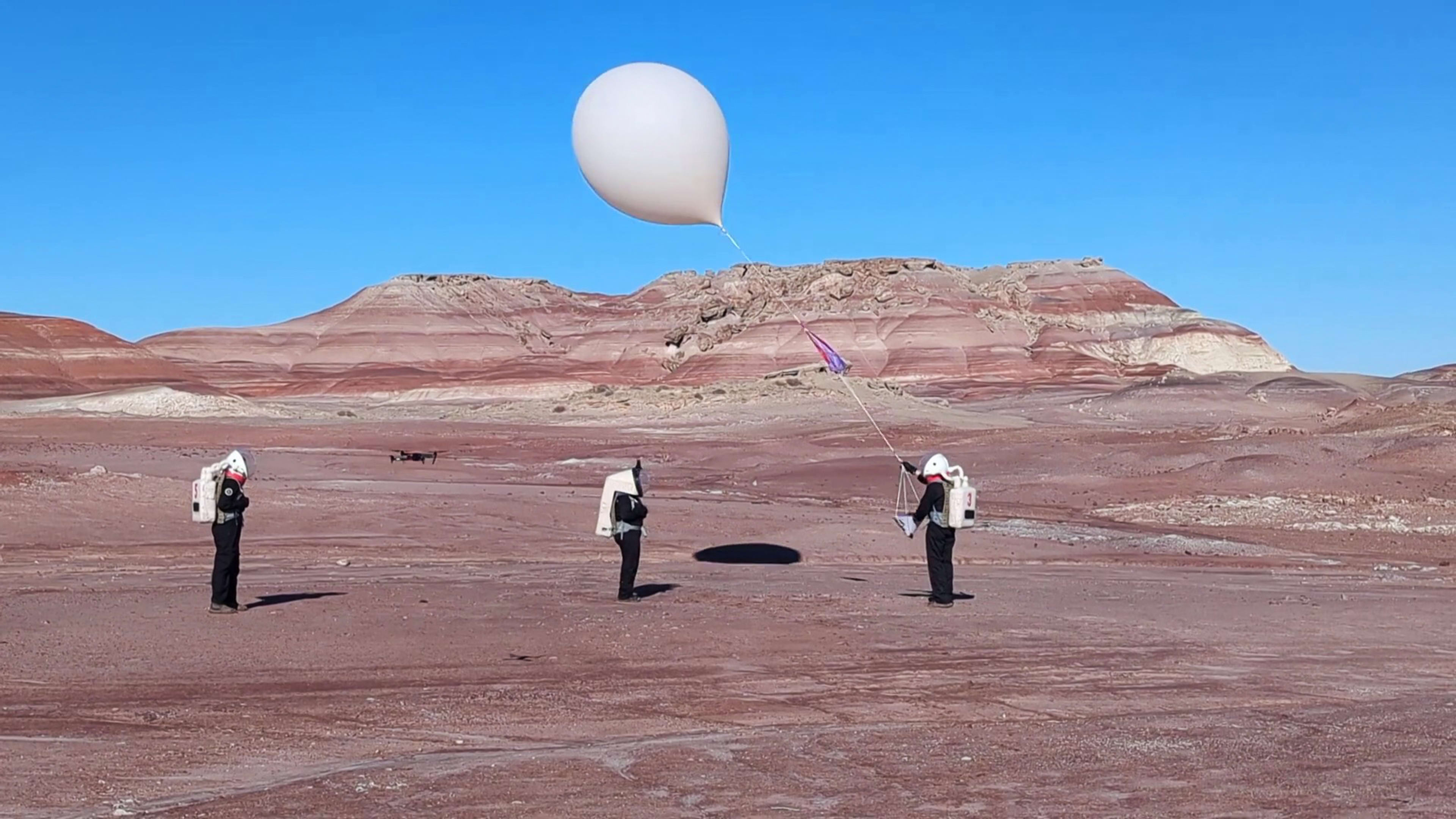Mars is only as good as its toilets.
Five days into a two-week simulated Mars mission in December 2022, the holding tank for the habitat’s RV-style latrine clogged, unleashing a stench that threatened to derail two years and thousands of dollars of scientific preparation.
This technically still being Earth, albeit a remote part, the “analog astronauts” could have called for a plumber. But doing so would have defeated the purpose of holing up in the Mars Desert Research Station (MDRS) in the isolated Utah desert to replicate living and working on a Martian base.
Salvation came in the form of Barbara Braun, the mission’s health and safety officer, who braved the front lines of commode combat, racing to clear out the sludge, so the tank could drain properly. “I was able to get it flowing again to where it would back up once every three days versus all the time,” she recalls. In a Hail Mary pass, she pulled out her ultimate weapon. “I had a small vial of eucalyptus essential oil, which proved to be mission critical.”
Braun was one of six engineers and scientists comprising the first analog Mars mission for The Aerospace Corporation, a 63-year-old El Segundo, CA-headquartered nonprofit that conducts R&D for the military, NASA, and commercial space industry. Although a few members had individually participated in simulations elsewhere, this mission—formally, MDRS 269—was the first all-Aerospace crew. Its purpose: to grow the skill sets of its employees working on human space flight projects, test new technologies in situ, and put researchers in the shoes of end-users.
“This experience presented us with the opportunity to feel like astronauts,” says mission commander Kristine Ferrone, Aerospace’s associate systems director of Agile Space Acquisition and Implementation. (Braun is the principal director of the company’s Enterprise Systems Engineering Office.)
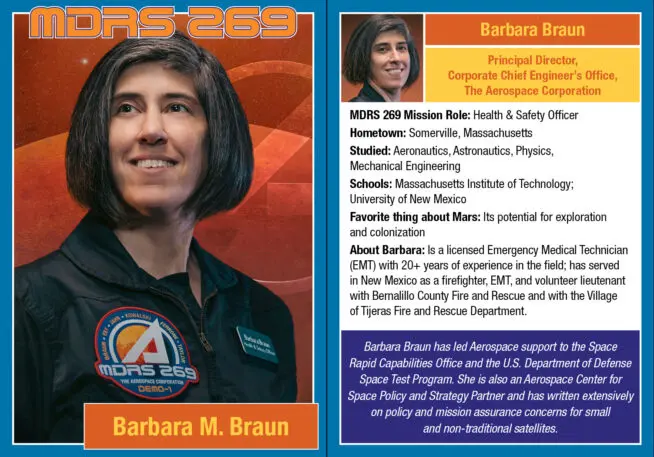
The lessons gleaned from its research could then be transferred to their customers. “Going out into the field is a stretch assignment. We’re usually on the front end advising the government,” says crew engineer Ashley Kowalski, Aerospace’s project leader for International Partnerships. “It gives us that knowledge to be able to do that early development work because we have an idea of how to do it out in the field.”
Renewed aspirations to return humans to the moon via NASA’s Artemis missions and possibly onward to Mars have ramped up immersive research in lunar and Mars-like environments that might involve desolate deserts and rocky terrains, reduced gravity simulations, or confined dwellings. They include facilities around the globe ranging from the more established Aquarius Reef Base in the Florida Keys and Hawai‘i Space Exploration Analog and Simulation (HI-SEAS) to the newly minted Space Analog for the Moon and Mars (SAM) at the University of Arizona Biosphere 2, and Crew Health and Performance Exploration Analog (CHAPEA) habitat at NASA’s Johnson Space Center in Houston, where a four-person crew is currently serving a yearlong mission.
The MDRS near Hanksville, Utah, which housed the Aerospace “astronauts” and Mission Control team, is among a handful of analog Mars bases built by The Mars Society. Others include the Flashline Mars Arctic Research Station (FMARS) in the Canadian Arctic’s Devon Island and the planned Mars Australia Research Station (MARS) in South Australia’s Arkaroola Wilderness Sanctuary.
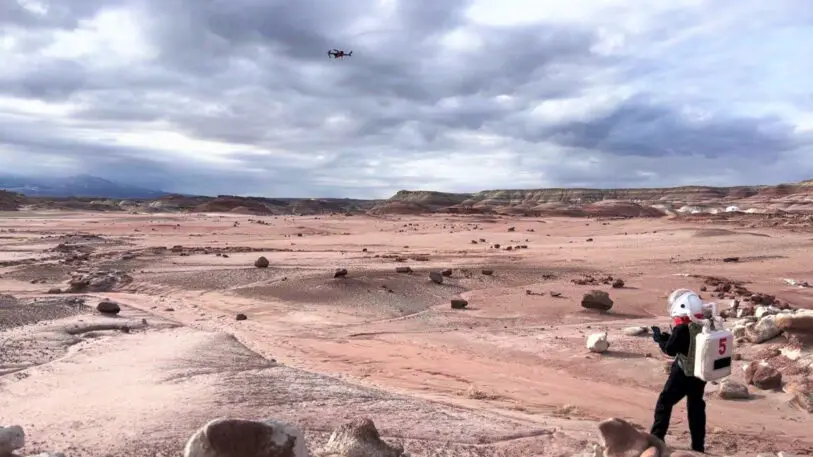
These environments help researchers troubleshoot the challenges of sending humans to the moon and Mars for extended stays, and design the studies that future astronauts might benefit from or conduct. Teams have tested food systems and growth, gathered geological samples for analysis, navigated tool use and equipment failures, and monitored behavioral and physiological responses to contained isolation with limited resources.
The purpose of the Aerospace mission was to run its engineers and scientists through the arc of a space mission—from planning to on-site operations fieldwork to postmortem analysis—within the framework of company objectives and customer needs. The mission has paid dividends since ending last December, bolstering Aerospace’s technical capabilities that will eventually benefit space-bound clients through revamped approaches to experiment designs and systems engineering workflows, field-testing technologies, increased research funding, and even one patent submission.
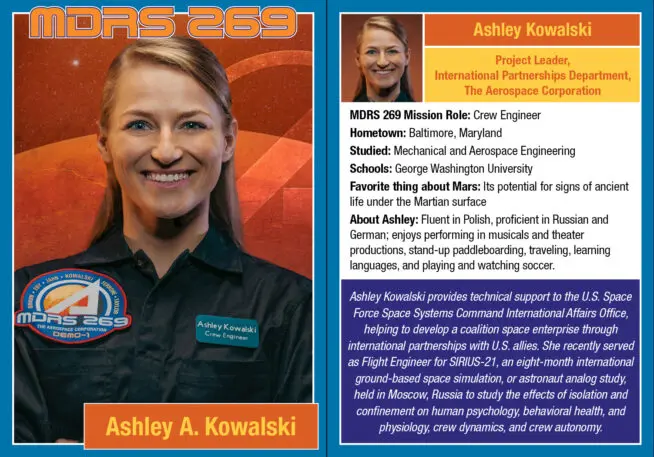
“We are trying to prepare ourselves for questions coming down the pipeline,” says Kowalski. “If we want to be at the forefront of cislunar operations [between the Earth and moon], then human space flight is a huge part of that. The more experts we develop and hands-on experience we get, the better we can increase the technological readiness of experiments and make suggestions for future procedures.”
From the lab to the land
A good portion of the mission focused on the operations of transitioning both people and experiments from a sealed habitat to harsh “extraterrestrial” surroundings. Tasks involved donning bulky mock spacesuits with limited dexterity and fields of vision, then heading out in ATVs to record radiation levels, gather rock samples, and field-test technologies.
“Anytime you move from a safe and comfortable environment, such as in a lab, you have to take an inventory of all the stuff you need to bring with you,” says mission executive officer Allison Taylor, a senior project leader in Aerospace’s Human Exploration and Space Flight Division. “That was a big challenge logistically; how are we going to get it out there?”
Taylor accidentally broke her spacesuit the first time she tried it on. The suits required charging before use and Taylor forgot to unplug hers before walking away, rupturing some connectors that were only fixed thanks to some guidance from Mission Control.
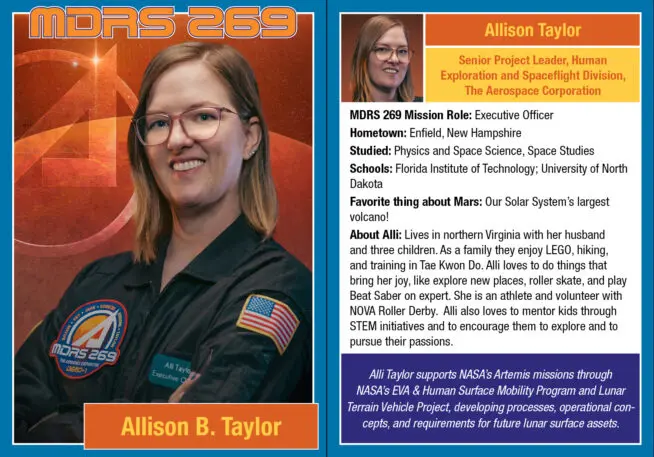
“We didn’t have that planned into our day and had to figure out a time to insert this repair,” she says. “I don’t think we were quite aware of the amount of time to maintain and check on equipment [that would] cut into operating the facility.”
Beyond expected tasks, crew members found themselves soldering connectors, replacing fuses and air filters, and troubleshooting failing spacesuit batteries. “All of these things speak to the need for competent self-sufficient crews with skills that you wouldn’t necessarily think of as being space flight skills,” says Braun.
The unexpected duties required adjustment from even the most seasoned simulation veterans. Ferrone, a former flight planner for the International Space Station, spent time at the Flashline station in Canada. Kowalski spent a whopping eight months in a sealed habitat as part of the Scientific International Research in Unique Terrestrial Station (SIRIUS-21) mission in Moscow gauging the psychological and physiological effects of confined living. Both were accustomed to more ground-led instructions that crews followed.
“One of the surprising things for me was the amount of planning the crew was doing for the activities of the mission,” says Ferrone. “In this case, since it’s more autonomous, the crew had a lot more say, control, and responsibility to plan the whole day’s activities and request permission to do [them] from mission support.”
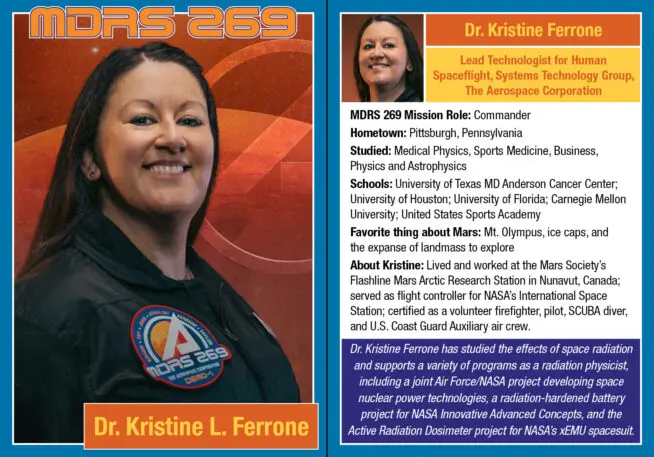
“It did feel like more of a realistic experience in that you were doing more operational types of work,” adds Kowalski. “This is how it would be in long-term missions. You can’t rely on Mission Control for everything.”
But mishaps and even just the unexpected were embraced simply as more data points. “We realized there were differences in the standard operating procedures that we needed to take into account,” says Kowalski. “Analogs are all about risk mitigation, so things run smoothly when the actual mission happens.”
Tech stress testing
Once in the field, the team investigated how various prototypes behaved in extreme conditions. They included measuring the degradation of mirror coatings to determine which were better suited for space and recording the first radiation measurements from that location, which they added to a global database.
Mission GreenHab (greenhouse) officer Matthew Eby, an engineering specialist in Aerospace’s Engineering and Technology Group, launched a low-cost weather balloon to gauge dust particles up to 90,000 feet. “So, if I’m a human outpost on Mars and I see a dust storm coming my way, I don’t have to plan out two or three months in advance. I can deploy this within an hour or two,” he says.
One of the mission’s biggest successes was improving a nascent application that incorporated augmented and virtual reality into 3D models of an operational space. The tech, dubbed “Project Phantom,” allows researchers to superimpose instructions over specific physical areas to guide others conducting experiments in those spots.
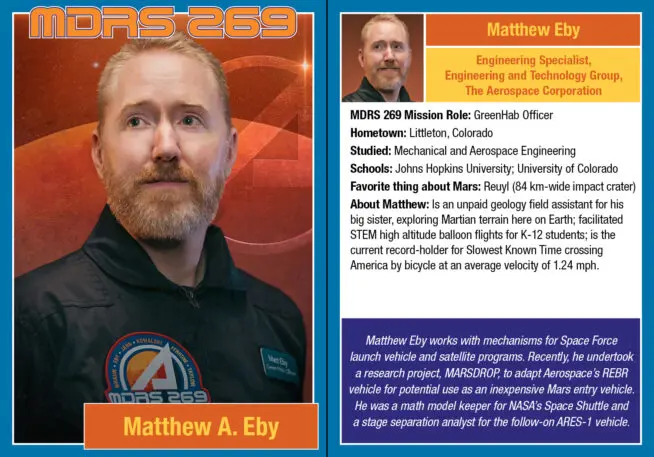
“I tried to demonstrate different ways astronauts might make and use a 3D model enhanced with holograms and annotations placed in augmented reality by off-world scientists, we’d call ‘phantoms,’” says mission technology officer Trevor Jahn, an Aerospace Space Architecture engineering specialist. “This enables back-and-forth communication as if you were interacting with an individual who was physically present.”
Jahn planned to create a 3D model of the surrounding landscape using a 360-degree camera strapped to a rover. But the unpredictable environment had other ideas. Despite the Phantom rover’s well-researched suspension system and gears to stabilize the images over rough terrain, the model quality wasn’t up to snuff. Jahn improvised by using a drone he’d brought along to gather better images. “That was something I couldn’t prepare for because I couldn’t drive the rover through all these gullies” in lab conditions, he says.
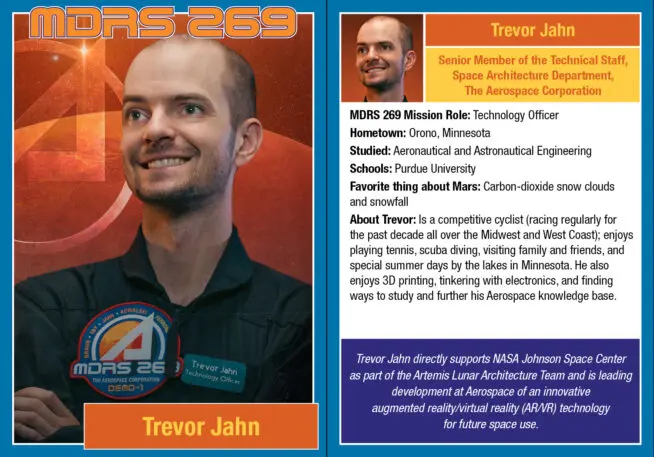
Meanwhile, the remote area unveiled GPS inaccuracies in the program that were less apparent in the more connected Los Angeles, and Jahn’s initial technical methods used for aligning virtual and physical images to superimpose holograms proved insufficient. From the data gathered during the mission, Jahn was later able to fix the glitches. The successful result enabled additional funding from other Aerospace offices and helped finalize a patent application in September. The company is now working on getting the technology licensed and developed for space and other applications.
“Those two weeks at MDRS were more valuable than the previous six months in the laboratory,” he says. “This is a great opportunity to stress test the experiments we have to make assumptions about when we’re not in the field.”
Phoning home
Other tests had more to do with psychological aspects. The crew (plus alternate Alejandro Diaz, Aerospace’s Human Exploration and Space Flight senior project leader) spent two years of weekly virtual meetings and an in-person training session leading to the mission. “We’re working with people we have worked with in the past but have not lived with,” laughs Taylor. “So that introduces a whole suite of new interactions.”
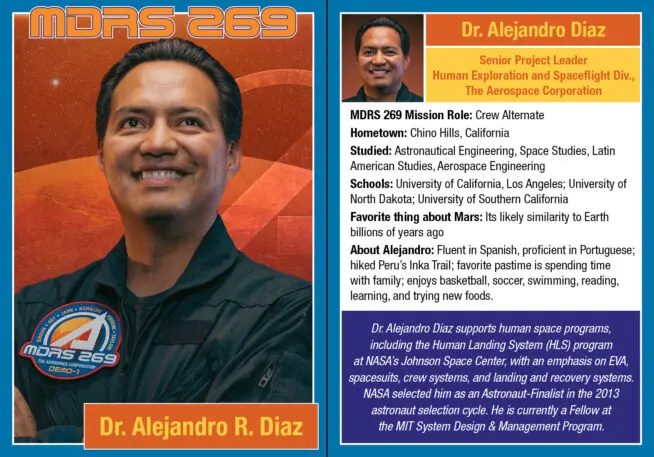
One study tracked crew communication with “Earth” to gauge how they coped with the disconnection from loved ones and lack of work-life separation. The researchers spoke to Mission Control in real-time, as though it was another Martian base. But software routed personal messages through a cached texting system that delayed delivery by 10 minutes to mimic the wait they would have experienced on Mars given its distance from Earth at the time and the low bandwidth of the deep-space transmission pipeline.
The idea to text came from Braun’s then-16-year-old son, Elias, who developed a special server that would hold messages for the time specified before delivering them to the intended recipients. “He was very excited to do it,” says Braun, despite noting the effect was not so different from home. “If my kids respond to texts within 20 minutes of my sending them, it’s a good day.”
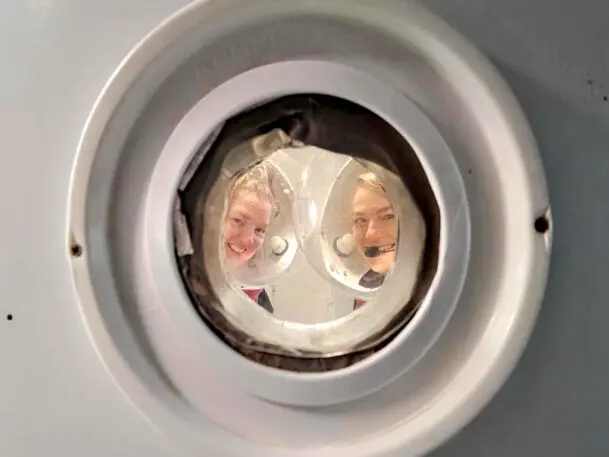
Roughly 80 percent of the more than 3,500 texts sent and received during the two weeks were between crew members and their friends and family. “That was one way to combat the isolation,” she says.
Some of the crew brought activities, like Eby’s painting project, which had each team member tackling a different part of a canvas. But even morale boosters had unintended consequences. Braun made fresh bread and pizza crust, but blew through the salt stash in the process. “We referred to that as ‘SaltGate,’” she laughs. On Mars, “you can’t just order it on Amazon and have it show up overnight.”
At times, the crew found themselves pondering the more existential elements of their roles in laying the groundwork for future spacefarers. “One of my lasting impressions was to take a moment to really enjoy the great adventure that we’re all on in this space exploration,” says Eby.
That feeling was most alive during a virtual STEM Q&A the crew had with more than 1,100 K-12 students during the mission. “Just looking at our screens filled with all these kids was one of these moments, not only the mission but my life, to be able to see that level of interest and engagement,” says Braun. “It made everything, even the toilet, worthwhile.”
Recognize your brand’s excellence by applying to this year’s Brands That Matter Awards before the early-rate deadline, May 3.
